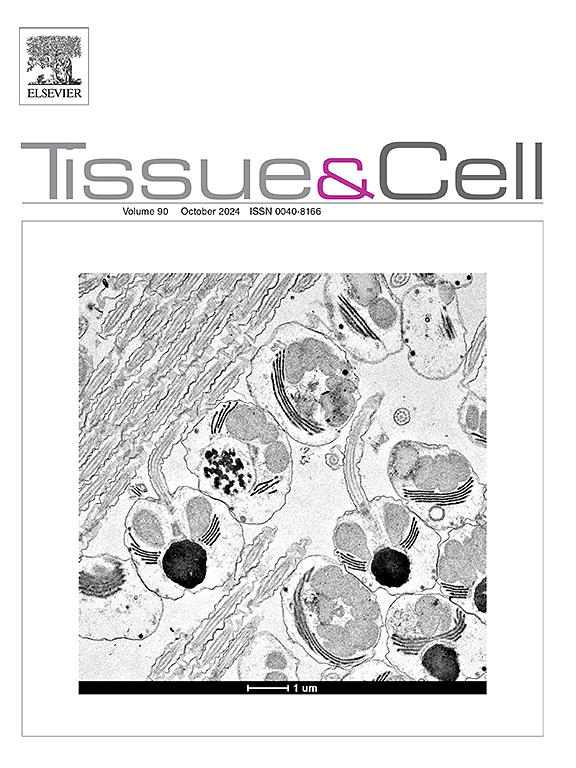贝那卡珊对焦亡的抑制:一种减轻急性肺损伤和多器官功能障碍的潜在策略
IF 2.7
4区 生物学
Q1 ANATOMY & MORPHOLOGY
引用次数: 0
摘要
由感染和创伤引起的急性肺损伤(ALI)引起了重大的公共卫生问题。caspase-1的激活触发白细胞介素-1β (IL-1β)的表达,导致焦亡。靶向焦亡可能为ALI提供治疗益处。本研究评估了caspase-1抑制剂belnacasan (Bel)在脂多糖(LPS)诱导的小鼠ALI模型中减少焦亡和减轻多器官功能衰竭的治疗潜力。方法30只BALB/c小鼠分为5组(n = 6):对照组、LPS组、LPS+Bel组、Bel组和DMSO组。LPS组给药5 mg/kg LPS, LPS+Bel组给药50 mg/kg belnacasan。对肺组织进行组织病理学、免疫组织化学和超微结构分析。通过组织病理学评估和生化指标评估器官损伤,包括肝脏ALT/AST和肾脏BUN/肌酐。通过c反应蛋白(CRP)水平评估炎症。ELISA法检测支气管肺泡灌洗液(BALF)中IL-1β水平,共聚焦显微镜检测肺泡巨噬细胞水平。结果贝那卡珊治疗可通过抑制焦亡和保存组织形态来减轻多器官功能障碍。CRP、ALT、AST、BUN和肌酐水平证实了组织病理学结果。免疫荧光和ELISA结果表明,贝那卡珊治疗可抑制IL-1β,减少BALF中嗜热性和非嗜热性肺泡巨噬细胞。透射电子显微镜(TEM)分析显示,belnacasan保留了血气屏障的完整性。结论belnacasan能抑制ALI的焦亡,减轻炎症,保持器官形态。这些发现强调了其作为预防ALI患者多器官功能障碍的治疗药物的潜力。本文章由计算机程序翻译,如有差异,请以英文原文为准。
Inhibition of pyroptosis by belnacasan: A potential strategy for mitigating acute lung injury and multiple organ dysfunction
Introduction
Acute lung injury (ALI) caused by infections and trauma poses a significant public health concern. The activation of caspase-1 triggers the expression of interleukin-1 beta (IL-1β), leading to pyroptosis. Targeting pyroptosis may offer therapeutic benefits in ALI. This study evaluates the therapeutic potential of belnacasan (Bel), a caspase-1 inhibitor, in reducing pyroptosis and mitigating multi-organ failure in a murine ALI model induced by lipopolysaccharide (LPS).
Methods
Thirty BALB/c mice were divided into five groups (n = 6): control, LPS, LPS+Bel, Bel, and DMSO. The LPS group received 5 mg/kg LPS, while the LPS+Bel group was treated with 50 mg/kg belnacasan one hour post-LPS. Histopathological, immunohistochemical, and ultrastructural analyses were conducted on lung tissues. Organ damage was assessed through histopathological evaluation and biochemical markers, including ALT/AST for livers and BUN/creatinine for kidneys. Inflammation was evaluated through C-reactive protein (CRP) levels. IL-1β levels in bronchoalveolar lavage fluid (BALF) were measured using ELISA, and alveolar macrophages were analysed via confocal microscopy.
Results
The findings suggest that belnacasan treatment may reduce multiple organ dysfunction by inhibiting pyroptosis and preserving tissue morphology. The CRP, ALT, AST, BUN, and creatinine levels corroborate the histopathological results. Immunofluorescence and ELISA findings indicate that belnacasan treatment can inhibit IL-1β and reduce both pyroptotic and non-pyroptotic alveolar macrophages in BALF. Transmission electron microscopy (TEM) analyses revealed that belnacasan preserved the integrity of the blood-air barrier.
Conclusions
Belnacasan inhibits pyroptosis, reduces inflammation, and preserves organ morphology in ALI. These findings underscore its potential as a therapeutic agent for preventing multiple organ dysfunction in ALI.
求助全文
通过发布文献求助,成功后即可免费获取论文全文。
去求助
来源期刊

Tissue & cell
医学-解剖学与形态学
CiteScore
3.90
自引率
0.00%
发文量
234
期刊介绍:
Tissue and Cell is devoted to original research on the organization of cells, subcellular and extracellular components at all levels, including the grouping and interrelations of cells in tissues and organs. The journal encourages submission of ultrastructural studies that provide novel insights into structure, function and physiology of cells and tissues, in health and disease. Bioengineering and stem cells studies focused on the description of morphological and/or histological data are also welcomed.
Studies investigating the effect of compounds and/or substances on structure of cells and tissues are generally outside the scope of this journal. For consideration, studies should contain a clear rationale on the use of (a) given substance(s), have a compelling morphological and structural focus and present novel incremental findings from previous literature.
 求助内容:
求助内容: 应助结果提醒方式:
应助结果提醒方式:


